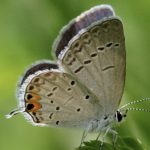NATURE NOTES: Butterflies
By Robin Ecklund
Did you know that BUTTERFLIES don’t nectar just on flowers? Some butterflies, such as mourning cloaks, suck tree sap. Little blues (butterflies that look like sparking blue flax petals) probe the mud in puddles for minerals with a long proboscis, a sort of tube usually curled up against their face. It can be unfurled and used like a drinking straw. Swallowtails and other butterflies also engage in “puddling”. Butterflies are most active when it’s warm, look for them on a sunny day after mid-morning.
Source: Wild Boulder County
by Ruth Carol Cushman & Steve Jones
Japanese Beetles
The Japanese beetle is an invasive pest that was introduced into the eastern United States over 100 years ago. Since the early 1900s, the insect has made its way West, moving long distances in nursery stock (root balls of trees, shrubs, and turfgrass plants) sold in trade and about 1 to 5 miles per year on its own from plant to plant.
The Japanese beetle was first introduced into Colorado in the early 1990s from nursery stock purchased in the mid-western United States. Scientists and experts were caught off guard by the ability of the pest to establish itself in our region, thinking that Japanese beetle, an insect that likes moisture and humidity would never become a problem in the semi-arid Colorado climate. However, our urban landscape areas are oases of green, irrigated plant material that the beetle loves to eat and thrive in.
Precautions need to be taken to keep this pest from spreading to noninfested areas of the State. Why? Japanese beetle adults are voracious feeders and cause significant damage to over 300 different plant species found in our landscapes, our agricultural areas, and a few of our native plants as well!
https://ag.colorado.gov/plants/pest-survey/japanese-beetle-in-colorado
Use of a variety of integrated pest management (IPM)/Plant Health Care (PHC) approaches, which combine multiple management tools, is highly encouraged.
1.Utilize plants that are not susceptible to Japanese beetle whenever possible. This can mean many things to many people; while one might not want to plant roses, grapes or otherhighlyattractive plants in their landscape,another might choose to eliminate turfgrass or other attractive plants.
2. Reduce irrigation to turfgrass areas. Japanese beetle adult females seek out well irrigated Kentucky bluegrass or other turfgrasses in which to lay their eggs. Try to make this area as unattractive to the pest as possible.
3. Hand pick or physically remove adults. Research suggests that this is actually a very effective management strategy as it reduces feeding-induced plant volatiles. It’s the plant volatiles emitted when a beetle feeds that attracts more and more. So by picking the beetles off and dropping them into a bucket of soapy water each evening, there are fewer beetles which leads to less feeding and less volatiles released to attract more beetles. Japanese beetles drop readily when disturbed to they can easily be collected by holding a jar or container beneath filled with soapy water.
Source- Colorado Department of Agriculture



